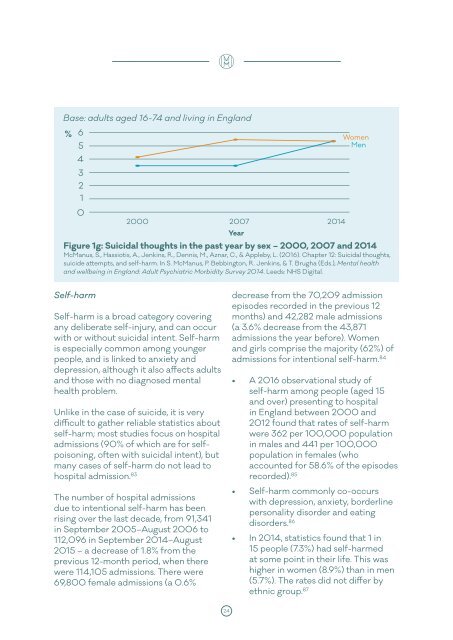FUNDAMENTAL FACTS ABOUT MENTAL HEALTH 2016
fundamental-facts-about-mental-health-2016
fundamental-facts-about-mental-health-2016
Create successful ePaper yourself
Turn your PDF publications into a flip-book with our unique Google optimized e-Paper software.
Base: adults aged 16-74 and living in England<br />
%<br />
6<br />
5<br />
4<br />
3<br />
2<br />
1<br />
Women<br />
Men<br />
0<br />
2000 2007 2014<br />
Year<br />
Figure 1g: Suicidal thoughts in the past year by sex – 2000, 2007 and 2014<br />
McManus, S., Hassiotis, A., Jenkins, R., Dennis, M., Aznar, C., & Appleby, L. (<strong>2016</strong>). Chapter 12: Suicidal thoughts,<br />
suicide attempts, and self-harm. In S. McManus, P. Bebbington, R. Jenkins, & T. Brugha (Eds.), Mental health<br />
and wellbeing in England: Adult Psychiatric Morbidity Survey 2014. Leeds: NHS Digital.<br />
Self-harm<br />
Self-harm is a broad category covering<br />
any deliberate self-injury, and can occur<br />
with or without suicidal intent. Self-harm<br />
is especially common among younger<br />
people, and is linked to anxiety and<br />
depression, although it also affects adults<br />
and those with no diagnosed mental<br />
health problem.<br />
Unlike in the case of suicide, it is very<br />
difficult to gather reliable statistics about<br />
self-harm; most studies focus on hospital<br />
admissions (90% of which are for selfpoisoning,<br />
often with suicidal intent), but<br />
many cases of self-harm do not lead to<br />
hospital admission. 83<br />
The number of hospital admissions<br />
due to intentional self-harm has been<br />
rising over the last decade, from 91,341<br />
in September 2005–August 2006 to<br />
112,096 in September 2014–August<br />
2015 – a decrease of 1.8% from the<br />
previous 12-month period, when there<br />
were 114,105 admissions. There were<br />
69,800 female admissions (a 0.6%<br />
decrease from the 70,209 admission<br />
episodes recorded in the previous 12<br />
months) and 42,282 male admissions<br />
(a 3.6% decrease from the 43,871<br />
admissions the year before). Women<br />
and girls comprise the majority (62%) of<br />
admissions for intentional self-harm. 84<br />
• A <strong>2016</strong> observational study of<br />
self-harm among people (aged 15<br />
and over) presenting to hospital<br />
in England between 2000 and<br />
2012 found that rates of self-harm<br />
were 362 per 100,000 population<br />
in males and 441 per 100,000<br />
population in females (who<br />
accounted for 58.6% of the episodes<br />
recorded). 85<br />
• Self-harm commonly co-occurs<br />
with depression, anxiety, borderline<br />
personality disorder and eating<br />
disorders. 86<br />
• In 2014, statistics found that 1 in<br />
15 people (7.3%) had self-harmed<br />
at some point in their life. This was<br />
higher in women (8.9%) than in men<br />
(5.7%). The rates did not differ by<br />
ethnic group. 87<br />
24


